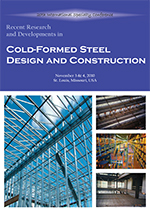Session Dates
03 Nov 2010
Abstract
Power-actuated fasteners (PAFs), also referred to as pins, are small nail-like or threaded stud t ype connectors. They can be used in conjunction with several materials and in a number of different applications. Typical applications in steel include attachments of deck sh eeting or diaphragms, architectural or mechanical components, or miscellaneous support brackets or connections to supporting steel members. Traditionally, the design strength of the connections featuring power-actuated fasteners has been determined through standardized testing protocols. In the United States, this protocol is embodied in the American Society for Testing and Materials (ASTM) Standard E 1190. The purpose of this study was to create a generic strength prediction model for pins embedded in steel substrate and subjected to either shear or tension, and to present the equations in a limit states fo rmat applicable to the North American practice and applications.
Department(s)
Civil, Architectural and Environmental Engineering
Research Center/Lab(s)
Wei-Wen Yu Center for Cold-Formed Steel Structures
Meeting Name
20th International Specialty Conference on Cold-Formed Steel Structures
Publisher
Missouri University of Science and Technology
Document Version
Final Version
Rights
© 2010 Missouri University of Science and Technology, All rights reserved.
Document Type
Article - Conference proceedings
File Type
text
Language
English
Recommended Citation
Mujagic, J. R. Ubejd; Green, Perry S.; and Gould, William G., "Strength Prediction Model for Power Acutated Fasteners Connecting Steel Members in Tension and Shear-north American Applications" (2010). CCFSS Proceedings of International Specialty Conference on Cold-Formed Steel Structures (1971 - 2018). 9.
https://scholarsmine.mst.edu/isccss/20iccfss/20iccfss-session11/9
Strength Prediction Model for Power Acutated Fasteners Connecting Steel Members in Tension and Shear-north American Applications
Power-actuated fasteners (PAFs), also referred to as pins, are small nail-like or threaded stud t ype connectors. They can be used in conjunction with several materials and in a number of different applications. Typical applications in steel include attachments of deck sh eeting or diaphragms, architectural or mechanical components, or miscellaneous support brackets or connections to supporting steel members. Traditionally, the design strength of the connections featuring power-actuated fasteners has been determined through standardized testing protocols. In the United States, this protocol is embodied in the American Society for Testing and Materials (ASTM) Standard E 1190. The purpose of this study was to create a generic strength prediction model for pins embedded in steel substrate and subjected to either shear or tension, and to present the equations in a limit states fo rmat applicable to the North American practice and applications.



